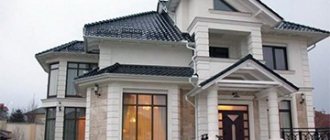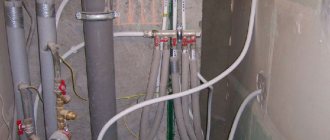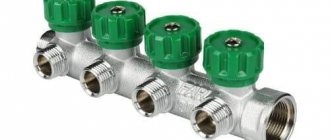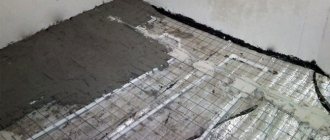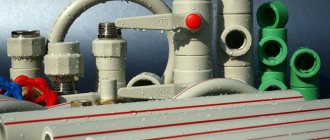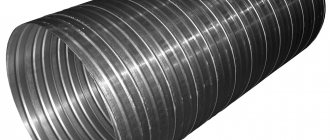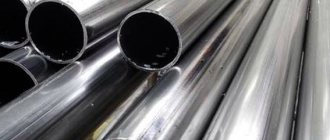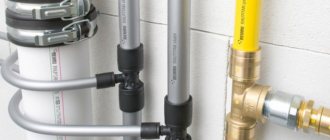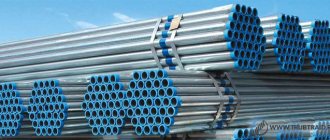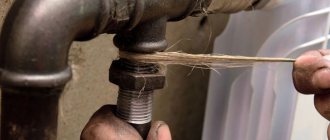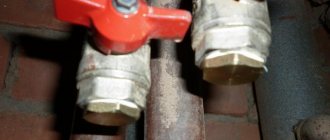Good day everyone!
Almost everywhere, plastic pipelines are replacing traditional metal ones. At the same time, the copper pipe recedes into the background. However, real connoisseurs of exceptional reliability know a lot about copper pipelines, and do not compromise on budgetary practicality at any price. We propose to understand the secret of such devotion to what seems to be a relic of the past, but in fact to the leader of pipe rolling.
Characteristics of copper
Copper (Cu, cuprum) is recognizable by its golden-pink hue, which, under the influence of carbon dioxide and moisture, first acquires an intense yellow-red color, and over time becomes covered with a film (patina) with a greenish-blue tint.
On a note! Patina not only gives copper products the appearance of noble, aristocratic antiquity, but also performs a protective function. Therefore, it is not recommended to clean it.
Basic physical and chemical characteristics of copper:
- High thermal conductivity.
- Malleability and ductility.
- Melting point - 1083⁰С.
- Not susceptible to corrosion.
- High electrical conductivity (2nd place among metals) and low electrical resistance.
- Inert towards most substances, fungi, mold, viruses and various bacteria.
- Resistance to ultraviolet radiation.
Application area
The scope of application of copper fittings is extremely wide. First of all, these are the usual cold and hot water supply and drainage systems, gas pipelines, plumbing and heating, including convector type and “warm floor” systems. In addition, copper pipes are actively used in air conditioning systems, heat exchangers of gas water heaters, cooling circuits of refrigerators, fuel installations for various purposes (in automobile, aircraft, and shipbuilding).
The aesthetic appeal of copper piping makes it possible not to hide communications inside walls or behind panels. In light of this, copper tubes are often used as a casing for electrical wiring, simultaneously serving as an insulator and a decorative element.
Types of copper pipes
Copper pipes can be classified according to several criteria:
- According to the manufacturing method, they are divided into the following types:
- Annealed pipes are produced by heat treatment. They are characterized by increased elasticity, which determines the scope of their application. In most cases, temperature-treated pipes are installed in air conditioning systems, heated floors, and refrigeration units. The main disadvantage of annealed pipes is the reduction in the strength of the material as a result of processing. Annealed pipes are produced in different diameters and are mainly sold in coils up to 50 m long;
Heat-treated copper pipes
To increase the strength index, annealed pipes can be manufactured with a protective shell.
- non-annealed pipes are highly durable, but less elastic. They are mainly used when installing heating, water supply, gas supply or sewerage systems. Unannealed pipes are also manufactured in different diameters and, as a rule, are supplied in lengths of up to 5 m;
Copper pipes of various diameters
- section type. Copper pipes can be produced in round or rectangular shapes. The latter are widely used for drainage systems;
Rectangular copper pipes
- sizes. For various pipelines, it is necessary to correctly select not only the outer and inner diameters, but also the thickness of the pipe wall.
Pipe parameters that need to be taken into account when selecting
Manufacturing methods and technologies
There are 2 main manufacturing technologies that ultimately affect the operational characteristics of the pipeline, its scope of application, as well as the cost of the pipes themselves and fittings for them:
- Rolling production.
- Welded production.
Upon completion, the pipes can be chrome-plated, painted and covered with a polyethylene or polyvinyl chloride sheath.
Rolling production
The rolling (seamless) method is considered the most common and provides maximum pipe strength. The essence of the technology is to give the copper billet (sleeve) the desired configuration by “cold” running it through the rotating rollers of a special pipe rolling machine.
Rolled pipes are recommended for installing water supply systems and heating circuits.
Welded production
Welded pipes are made of sheet copper, screwed onto a blank of a pressing shaft of the required size and shape and welded with an inert gas at the joint. After welding, the pipe is rolled on calibration rollers, which level it and eliminate longitudinal deformation of the weld.
Regulatory Requirements
As expected, all production and installation processes are strictly regulated by state standards.
Production
For the production of pipe fittings, copper alloys are used, the copper content of which is determined by Russian GOST 617-2006 (instead of GOST 617-90), R 52318-2005, 859–2001, 11383-75 and the European quality standard EN 1057, and, as a rule, never less than 99.5%. The following grades of copper are distinguished:
- M1. The copper content in combination with silver is 99.9%. The almost absolute purity of the alloy provides the best indicators of ductility, strength, thermal and electrical conductivity of the material. Brand M1 is recommended for heating circuits (max t working environment - 250⁰С), as well as cryogenic installations.
- M2. Copper and silver content – 99.7%.
- M3. - so-called technical copper, made as a result of secondary smelting or fire and electrolytic refining. Copper and silver content – 99.5%. Rolled metal of the M3 grade is characterized by good strength and affordable cost.
A decrease in the proportion of copper and an increase in the proportion of alloyed elements (nickel, tin, iron, lead, arsenic, etc.) primarily affect the electrical conductivity coefficient, significantly reducing it. The strength index remains practically unchanged.
Quality control standards are determined by GOST 24231-80 and 6507-90.
In addition to the chemical composition, the standards stipulate a number of technical conditions in accordance with which copper pipe fittings are produced:
- No delamination, cracks, rust or burrs on the ends.
- The inner surface of the pipes must be smooth and free of bulges that would impede the flow of the carrier. The permissible number of recesses and their size are strictly limited: no more than 2 per linear meter and up to 0.25 mm, respectively.
- Diameters correspond to established standard sizes.
- Support of each batch (coil) with technical documentation and labeling.
The marking is deciphered as follows:
- Manufacturing technology:
- D – Cold-deformed rolled.
- G – Pressed.
- Cross section shape:
- KR (K) – Round.
- PP – Rectangular.
- PC – Square.
- PO – Oval.
- Production accuracy:
- P – increased accuracy.
- N – within the normal range.
- K – accuracy of wall thickness.
- And – reference diameter accuracy.
- B – length accuracy.
- O – curvature accuracy.
- P – standard for stretching.
- N - Vickers hardness.
- Type of plasticity:
- M/L – soft.
- P/F – semi-solid.
- T/H – hard.
- Length designations:
- ND – non-gauge pipeline.
- MD/KD – measuring pipeline.
- BT - bay.
- Coil winding shape designation:
- BU - ordered.
- BS – spiral.
An example of decoding the markings is shown in the photo below:
Installation
Installation and operation standards are set out in SP 40-108-2004:
- The connection of copper communications with pipelines made of steel and aluminum is carried out in a strictly defined sequence: in front of the copper sections in the direction of movement of the carrier. Failure to comply with this principle leads to the effect of electrochemical corrosion. There are no special restrictions regarding brass and plastic pipes.
- The maximum permissible speed of the carrier in the circuit is 2 m/s.
- The water hardness index should be in the range from 1.42 to 3.1 mEq/l. Other indicators deplete copper resources.
Important! Special requirements are imposed on the degree of purification of the transported liquid. The presence of solid particles in the composition reduces the service life of the pipeline, because soft metal wears out under their influence. To prevent this problem, a mechanical cleaning filter is installed at the inlet.
General characteristics and diameters of copper pipes
Characteristics
One of the main advantages of copper pipes is the fact that they do not enter into any reactions and are completely impermeable to various types of liquids, such as oils or fats.
If we consider the influence of chlorine contained in tap water, then its influence is not only harmless to the copper pipe, but also contributes to the formation of a protective layer inside it.
Just like plastic, a copper pipe is good because it is not subject to growth on the inside or outside, for example, limescale, etc.
Moreover, based on GOST, copper copes well with different temperature ranges (from -200 to +250 degrees), while showing high resistance to temperature changes.
If we compare copper and plastic products that are used for the construction of water supply systems, the former are not afraid of exposure to ultraviolet radiation, and their external color is created rather to improve the appearance, suitable for a specific interior. If you want to install pipes outside, then you should choose chrome-plated copper products.
Diameter table
| Diameters in inches | Dimensions, mm. |
| 1/4″ | 6.35 x 0.8 |
| 3/8″ | 9.53 x 0.8 |
| 1/2″ | 12.7 x 0.8 |
| 5/8″ | 15.9 x 0.8 |
| 3/4″ | 19.1 x 0.8-0.9 |
Copper pipe price
| Diameter, mm | Wall thickness, mm | Price, m.p./rub. |
| 12 | 1 | 215 |
| 15 | 1 | 180 |
| 18 | 1 | 325 |
| 22 | 1 | 400 |
| 28 | 1 | 545 |
| 35 | 1,5 | 1020 |
| 42 | 1,5 | 1250 |
| 54 | 1,5 | 1700 |
Sections and dimensions
The most popular is copper pipe rolling with a classic round section. Pipes of non-standard rectangular cross-section are used less frequently, mainly in mechanical and instrument making or indoors, based on design considerations.
Pipe dimensions (inner and outer diameters, wall thickness) can be indicated in millimeters and inches (English unit of length equal to 25.4 mm). To make it easier to convert one value to another when choosing pipes and fittings of Russian and foreign production, special tables are used.
Often the standard size of pipes is indicated in the form of fractional markings, for example - 15/1. In this case, the numerator (first number) indicates the outer diameter, and the denominator (second number) indicates the wall thickness. The difference between the two values is the internal diameter of the pipe.
Copper pipe: diameter 15
The most popular, durable and relatively inexpensive copper pipe, diameter 15 mm - 20 mm (or ½ and ¾) is used in Europe and the Russian Federation as the basis for heat exchange networks of the following closed systems:
- Heating system;
- Refrigeration unit;
- Solar battery;
- Split system.
Another common size, which is designated using a 5/8 copper pipe, the diameter in mm is 16. In addition, there are general concepts such as nominal diameter and wall thickness. It is important to know the nominal diameter when purchasing fittings connecting individual sections of pipeline (also measured in mm and inches). You may also want to buy a square stainless steel pipe.
Advantages and disadvantages of copper pipes
The physical characteristics of copper in symbiosis with production methods determine the operational characteristics of copper pipe products, which are resistant to:
- Corrosion, which not only extends the life of the pipeline, but also does not have a negative impact on the operation of plumbing fixtures.
- Temperature changes while maintaining the integrity of linear parameters.
- Water hammer. The operating pressure of the circuit is from 100 to 450 atmospheres.
- Vibrations, due to which copper pipelines are actively used in seismically unstable regions, including for the installation of gas distribution.
- UV rays (unlike thermoplastic polymers, which are destroyed by ultraviolet radiation). Copper pipeline painting is carried out solely for the purpose of adapting it to a specific interior.
Other advantages of copper pipes include:
- Wide range of operating temperatures - from -200⁰С to 350⁰С (depending on the pipe manufacturing method and the type of pipeline connection).
- An absolutely smooth surface that prevents the formation of build-ups of organic and inorganic origin inside the circuit, without reducing the throughput during operation, and also minimizes friction inside the circuit, which allows the use of pipes of smaller diameter without loss in the efficiency of the system.
- Plasticity is a guarantee of resistance to tearing. The coefficient of relative elongation (expansion) is 10-40%.
- Plasticity also facilitates installation work. Pipes can be easily bent in any direction using ordinary hand tools, which is an undeniable advantage when creating complex pipelines.
- Despite all its softness, copper fittings excellently hold a given configuration, something that most plastic pipes cannot boast of.
- Lighter weight compared to steel and cast iron counterparts facilitates transportation, installation and minimizes the load on the structure.
- Chemical neutrality to salts, formaldehydes, methanol, and a number of acids with a pH level of no more than 9 prevents the destruction of copper. The lack of reaction with chlorine contained in tap water does not provoke the formation of oxides harmful to humans.
- The bactericidal properties of copper contribute to the partial disinfection of water. In copper pipelines, not only do microorganisms not multiply, but also the bacteria Staphylococcus aureus and the influenza virus of group A die.
- The low electrostatic index prevents the formation of sparks, which means that copper fittings can be safely used in flammable and explosive areas.
Among the disadvantages it should be noted:
- High cost, which, however, pays off over a long period of operation.
- The increased coefficient of thermal conductivity, on the one hand, increases the efficiency of the heating circuit, and this is a definite plus. On the other hand, the pipes run the risk of heating up to such an extent that touching them can cause a burn. The problem is solved by using pipes in PVC or PE braid.
- Condensation may form on cold water pipes. The problem is solved similarly to the previous paragraph.
- High electrical conductivity. However, the risk of electric shock is neutralized by installing grounding.
How to convert inches to millimeters
Metric parameters are very often used for external measurements of the diameters of copper pipes, and inches for internal ones. Use tables for converting inch values to millimeters.
Table 1
Pipe size, inches
| External diameter, mm | Equivalent diameter, mm | |
| 1/4 | 13,5 | 8 |
| 3/8 | 17 | 10 |
| 1/2 | 21,3 | 15 |
| 3/4 | 26,8 | 20 |
| 1 | 33,5 | 25 |
| 1+1/4 | 42,3 | 32 |
| 1+1/2 | 48 | 40 |
| 2 | 60 | 50 |
| 2+1/2 | 75,5 | 70 |
| 3 | 85,5 | 80 |
| 3+1/2 | 101,3 | 90 |
| 4 | 114 | 100 |
| 5 | 140 | 125 |
Dimensions in “mm” are converted to “inches”, rounded up. 1 inch is 25.4 mm, but rough rounding results in an error, which is important to consider when choosing a product range.
table 2
Inches
| 1/2 | 1 | 1/1/4 | 1/1/2 | 2 | 2/1/2 | 3 | 4 | 3 reasons for this
|
Kinds
Based on wall thickness, copper pipes are divided into thin-walled and thick-walled. The first is characterized by low weight, the second by increased strength.
In addition to standard copper pipelines, plastic insulated pipes are produced, which:
- Cools the surface of the pipe.
- Prevents condensation.
- Retains heat inside the circuit.
- Reduces noise levels.
Depending on the type of final processing, rolled tubes are divided into annealed and unannealed. Visually, they are easy to distinguish from each other: annealed, as a rule, are supplied in coils up to 50 meters long, unannealed - in straight sections.
Annealed
After rolling, the pipe is fired at temperatures up to 700⁰C. This procedure increases the ductility of products, increasing the stretch coefficient, but slightly reduces the safety margin.
Unannealed
They are not subject to additional heat treatment. They are characterized by maximum strength, bending rigidity, resistance to external damage and water hammer.
According to the degree of ductility, copper pipes are classified into:
- Solid (most often unannealed modifications). Marked as H, T, F30 or Z6. Recommended for the installation of central water supply channels characterized by high pressure of the working environment. In this case, the main line is predominantly straight with a minimum number of bends, which are made exclusively with the help of rotary fittings.
- Semi-solid. They are designated as НН, П or Z. Strength and elasticity indicators are perfectly balanced: the elongation coefficient reaches 10%, withstands expansion of the outer diameter up to 15%. Pipe bending is done using a pipe bender. Designed for heating, cold and hot water supply.
- Soft. Marked as M, F22, W or R. Elongation coefficient - up to 38%. Extension of outer diameter up to 25% is possible. The pipe configuration is easy to change with your own hands. Recommended for installation of “warm floors”.
What do you need to know about pipe parameters?
Length and diameter are common parameters expressed in digital equivalents to make it easier to measure and enter the value into formulas. But in reality, there are several indicators for measuring the thickness of pipes, and accuracy is required everywhere.
This is interesting! Discrepancies in measurements arose due to the introduction of copper pipes into European construction technologies from the mid-20th century. At that time, on our territory, the key standard was determined in millimeters - for metal products that are widely used even today. Domestic apartment buildings are equipped mainly with a steel water metering unit.
In European countries, private households with copper communications are more in demand. They are the most durable, resistant to corrosion, but have a high cost . Seamless products made from copper are little by little gaining their own market segment; they are also produced in accordance with GOST. They are used not only for plumbing communications, but also to ensure work:
- air conditioners;
- photovoltaic panels;
- refrigeration units;
- individual heating;
- parts for the automotive industry.
For a wide variety of pipeline segments, pipes of different sections are used, and it is necessary to know what diameter is suitable for a particular purpose
Methods for connecting copper pipes
To assemble a copper pipeline, threadless pipe joining methods are used:
- Capillary soldering.
- Crimping fitting pressing.
Before installation, the pipes are cut using a special cutter into pieces of the required length. It is important that the cut is perfectly even.
Soldering of pipelines
Capillary soldering is the most common and reliable method of connecting copper communications. The tightness of the soldered circuit allows the pipeline to be operated under conditions of high pressure and temperature.
An important condition for the formation of a high-quality sealed seam is the accuracy of the selection of the fitting connection. If the gap between the pipe and the fitting is more than 0.4 mm, the capillary effect does not form.
There are 2 soldering technologies:
- High temperature (hot), in which soldering is carried out at a temperature of 450-700⁰С. Thin wire made of silver, bronze or copper is used as solder.
- Low-temperature (cold), when the temperature regime is limited to the range of 200-250⁰С, and low-melting tin or lead is used for solder.
Due to the fact that heating changes the physical properties of copper, cold soldering is considered preferable. But it is prohibited to use lead solder for drinking water supply systems, because it is toxic. In any case, cooling of heated elements should occur naturally at room temperature.
Using a gas burner complicates the installation procedure, because requires the user to have appropriate skills. In addition, a certain amount of skill will be required to properly align the metal wire. However, the use of special copper fittings with solder already built inside makes the task much easier.
Pressing joints
The plasticity of copper allows the use of compression press fittings, crimp sleeves, clamps and flanges for joining pipes. Externally, press fittings are no different from those intended for soldering; the main difference is in the sealing method, which is ensured by:
- Internal sealing belt made of polymer.
- An internal copper ferrule that flattens when squeezed.
- Clamping the joint with special pliers (sliding wrench).
- A mounting nut that secures the clamping location.
On a note! There are 2 types of compression (collet) fittings. Type A is intended for joining solid and semi-rigid pipes; type B – for semi-hard and soft.
The disadvantage of a compression connection is the complexity of the design and the need for regular monitoring for leaks. Therefore, this joining method is chosen only when installing cold water supply systems or drains with low pressure and exclusively in areas accessible for inspection. However, the opportunity to do the work yourself and significantly save on hiring third-party specialists significantly compensates for these inconveniences.
Copper pipes and fittings for soldering to them
collapse Copper is resistant to aging and corrosion and can therefore be used in a wide range of applications. Metal not only withstands enormous loads, but also meets high reliability requirements, for example in the automotive industry, air conditioning, plumbing, heating systems, etc.
Copper pipes and fittings SANCO
The name SANCO comes from the French “sans corrosion” and means “without corrosion”, in air the corrosion rate is no more than 1 micron per year, in addition, a dense protective film (patina) is formed on the surface of copper pipes upon contact with water. It additionally protects the surface of the pipe and is able to recover from damage.
Copper is a metal. Therefore, it has a long service life: it does not age or deteriorate and retains its original strength (it is believed, for example, that a copper roof begins to “grow up” only after 20-30 years of operation).
Copper is not sensitive to ultraviolet radiation and other external influences. Chlorine contained in tap water has no destructive effect. As a strong oxidizing agent, chlorine promotes the accelerated formation of a patina layer after approximately 100 hours of use.
Copper pipes are highly durable. For a solid copper pipe with a diameter of 12 mm and a wall thickness of 1 mm, the permissible operating pressure is 100 bar and the temperature is 250°C. The melting point of copper is 1084°C.
Copper pipes are impermeable to oxygen, which is very important for heating systems.
Copper pipes have an insignificant coefficient of linear expansion (α = 0.017 mm/(m*K)). Depending on the hardness of copper, it can withstand 1 to 3 freezing cycles.
Copper pipes and fittings have bacteriostatic properties against certain types of microorganisms: on the surface of copper, bacteria stop multiplying and die over time. Patina does not weaken the antibacterial properties of drinking copper water pipes.
Installation of copper pipelines
There are several ways to install copper pipes, one of the most common methods is soldering. The connection of copper pipes by capillary soldering is characterized by automatic filling of the mounting gap with solder, which provides a guaranteed hermetically sealed connection. A wide soldering belt means that these connections are the strongest and most reliable elements of the system, stronger than the pipes themselves. Tensile tests have shown that the solder joints can withstand pipe rupture without failure.
Solder connections can be made using soft or hard solder:
- Soft soldering can be used in cold, hot water and heating pipelines with operating temperatures up to 110°C. It should always be done using flux or flux paste, which is a mixture of flux and powdered solder. In drinking water supply systems, only soft solders are used.
- Brazing has greater temperature resistance and higher shear strength and is used in heating systems. In drinking water supply systems, brazing can only be used for pipes with standard sizes larger than 28 * 1.5 mm.
The requirements for fittings for hard and soft solder are similar.
Brass or bronze solder fittings are used to connect copper pipes to steel pipelines. expand
Tips for installing and repairing copper pipes
- Because Copper is susceptible to mechanical stress; copper communications should be laid in places that are maximally protected from accidental damage, or a protective box should be installed.
- When laying copper communications inside walls, you should choose pipes with a polymer sheath. It will prevent the destruction of the metal.
- It is better to use copper, brass or bronze fittings for connections. Other materials will cause galvanic corrosion.
- Pipe joining can be done without using transition fittings. To do this, use a special pipe expander, with the help of which one section of the pipe expands to the required diameter. Then another pipe is inserted into it and soldering is carried out.
- In the event of a break in a copper pipeline, turnbuckles are used as a temporary solution to eliminate the leak.
Joining copper pipes with other materials
When laying communications from copper pipes, they can be joined with pipe products made of plastic, steel and brass. Regarding connections with galvanized products, experts recommend avoiding such combinations, since there is a high probability of chemical processes occurring between the two elements - copper and zinc.
When joining pipes of this type, brass fittings are used - they are mounted so that the water flow moves in the direction from zinc to copper.
Modern copper pipe products are durable and therefore such water supply would be an excellent choice.

